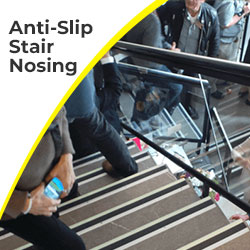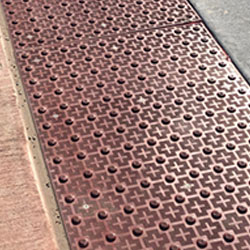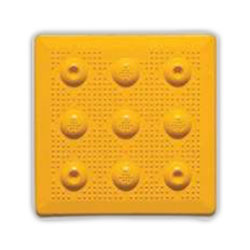




















































































































Whether renovating an existing building or constructing a new one, installing code-compliant stair nosings should be a top priority. Stair nosings (stair edge treads) are essential for safety, accessibility, aesthetics, and longevity.
This comprehensive buyer's guide by Tactile Solution Canada will walk you through everything you need to know before purchasing stair nosings for your project.
Stair nosings serve multiple important purposes:
The leading cause of injuries on stairs is slip and fall accidents. Stair nosings create traction and allow for safe traversal on the stairs by providing a non-slip surface with glow-in-the-dark visibility.
Photoluminescent stair nosings embedded with luminescent strips provide guidance in case of failure of the main power supply. Such stair edge markings enable safe egress and prevent trips or falls in darkened environments.
Quality nosings protect tread edges from cracking, chipping, peeling, or other physical damage. This saves money on repairs and replacements over the long run.
Stair nosings lend an ultra-modern, uniform look to stairs. Their sleek finish makes the stairs look neat and elegant.
Installing stair nosings allows compliance with local and national safety codes concerning slip resistance, visibility, and accessibility.
Now that you know why stair nosings are important, let's go over the buying considerations.
Follow this comprehensive checklist when purchasing stair nosings:
• Type of Substrate - Ensure compatibility with the stairs' surface material - concrete, wood, metal, tile, carpet, etc.
• Application Method - Choose nosings embedded into new concrete stairs or surface-bonded options for existing stairs.
• Dimensions - Take measurements and select the appropriate length, depth, height, and thickness.
• Safety Features - Opt for slip-resistant material with photoluminescent strips for visibility.
• Standards Compliance – Ensure nosings meet safety codes and standards like IBC, ACA, AODA, etc.
• Warranties - Select nosings backed by long-term manufacturer warranties.
Below, we explain each of these factors in detail.
Stair nosings need to be compatible with the stairs' surface material. Common options include:
• Concrete Stairs: Opt for nosings designed for installation in newly poured concrete or surface-bonding on existing concrete.
• Wood Stairs: Choose self-adhesive nosings for retrofitting wood stairs. Also suitable for laminate or parquet.
• Metal Stairs: Special heavy-duty bonding aluminum nosings explicitly made for metal pan stairs.
Cast-in-Place: Embedded into new wet concrete stairs during pre-construction. Sturdy and vandal-proof.
Surface-Applied: Bonded post-construction by gluing or screwing onto existing stairs. Easy retrofitting.
Use heavy-duty cast-in-place nosings for public infrastructure projects like mass transit systems and arenas. Opt for surface-applied nosings for simplicity for residential buildings and office renovation projects.
Proper stair measurements are vital for precise nosing sizes. Key dimensions:
• Length – Measure horizontally along the step edge.
• Height – Perpendicular distance between the tread and the underside.
• Thickness - Vertical depth from the wear surface to the bottom edge.
• Overlap - Extent of overhand over step edge or previous riser.
Follow manufacturer size charts based on rise height and tread depth. Order 1-2 inches longer to accommodate imperfect stair dimensions.
The primary purpose of stair nosings is safety through slip resistance and visibility. Our Ecoglo stair edge nosings provide:
• Slip Resistance: Opt for nosings with etched non-slip abrasives, ceramic grits, or carborundum crystals bonded to durable aluminum. These maintain traction in wet and dry conditions.
• Photoluminescence: Nosings with glow-in-the-dark strips provide guidance during power outages or darkness. Ensure luminance intensity, duration, and uniformity per local codes and standards.
Stair nosings must align aesthetically with interior décor. Consider nosing color, texture, pattern, sheen, and lighting elements. Match nosing colors to floors or walls. Our stair edge nosings are in federal yellow, grey, and black.
Ensure stair nosings conform to national and regional safety codes and standards.
• International Building Code (IBC): Provides egress and accessibility requirements in Chapter 10.
• Accessibility for Ontarians with Disabilities Act (AODA): The AODA Section 80.25 necessitates exterior access stairs to have full-width tread markings with slip-resistant, high-contrast finishes on the leading edge of each step.
• CSA Group Standards: Outlines illumination performance metrics for LLL stair nosings.
For Canadian projects, verify CSA B651 compliance. For the US, check ADA Title III compliance. For global projects, ensure conformance with ISO standards for safety.
Opt for nosings backed by long-term warranties. This safeguards against premature damage or wear.
Various nosing types are available based on specifications, site conditions, and budget. We explain a few common varieties below:
Description: Embedded into newly poured concrete stairs. Durable, seamless, and tamper-proof.
Types:
Photoluminescent: Glow-in-the-dark guidance
Non-Photoluminescent: Visible contrast sans glow element. Both feature non-slip surfaces.
Applications: Public infrastructure - mass transit, stadiums, external staircases.
Benefits: Robust, vandal-proof, long lifespan, safety compliance.
Description: Bonded post-construction by adhesives/screws onto existing stairs.
Types:
• Photoluminescent: Step edge glow strip plus non-slip surface
• Non-Photoluminescent: Contrasting nosing minus glow
Applications: Commercial and residential renovation projects.
Benefits: Easy retrofitting, quick installation, safety + aesthetics.
We outline the installation procedures for cast-in-place and surface-mounted nosings:
1. Prepare concrete mix as per the manufacturer's instructions
2. Pour concrete into stair forms
3. Level and smoothen the surface
4. Place nosings along step edges and press down for stability
5. Lightly tap nosings with a mallet for bonding with concrete
6. Repeat the process for each step
7. Allow adequate curing before removing formwork
1. Thoroughly clean and dry the application surface
2. Cut nosings to appropriate lengths
3. Apply adhesive manufacturer's recommended adhesive, like premium polyurethane adhesive, evenly
4. Position and press nosings firmly along step edges
5. Drill guide holes and insert screw anchors for stability
6. Allow adequate bonding drying time before use
7. Repeat the process on all steps
For detailed specifications, trust these installation guides.
Thoroughly clean the surface and remove any loose paint or sealant. Allow the surface to dry completely.
For concrete, use adhesive to allow for expansion/contraction. For timber, ensure the surface is dry for best adhesion.
Maximum recommended outdoor installation length is 1.5 meters with a 3mm gap between lengths.
Alignment:
Q: Are Tactile Warning Strips & Stair Edge Markings the same as Stair Nosings?
A: No tactile warning strips are designed to indicate hazards for visually impaired pedestrians before stairs or ramps. Stair edge markings are painted with contrast stripes. Stair nosings are durable, non-slip aluminum/metal profiles installed along step edges.
Q: Can Stair Nosings be installed outdoors?
A: Yes, stair nosings are explicitly rated for both indoor and outdoor durability. These feature UV resistance, frost/waterproofing, and corrosion protection for long-term outdoor performance.
Q: Why are Stair Nosings mandatory as per safety codes?
A: Codes like IBC, AODA, CSA, etc. require stair nosings to prevent slip & fall accidents and ensure safe emergency evacuation through adequate visibility. Stair nosings provide both non-slip grip and visual contrast.
Q: How often should nosings be inspected or replaced?
A: Quality stair nosings require minimal maintenance and last 10-20 years. However, annual inspections checking bonding, gaps, cracks, visibility, etc., ensure continued safety. Replace immediately if damage, wear, or performance issues are spotted.
Tactile Solution Canada is your trusted stair safety specialist supplying the highest-quality Ecoglo stair nosings across Canada.
For uncompromising stair safety, enhanced aesthetics, and reliability, look no further than Tactile Solution Canada for all your stair-nosing needs. Reach out today for personalized product recommendations from industry experts.
